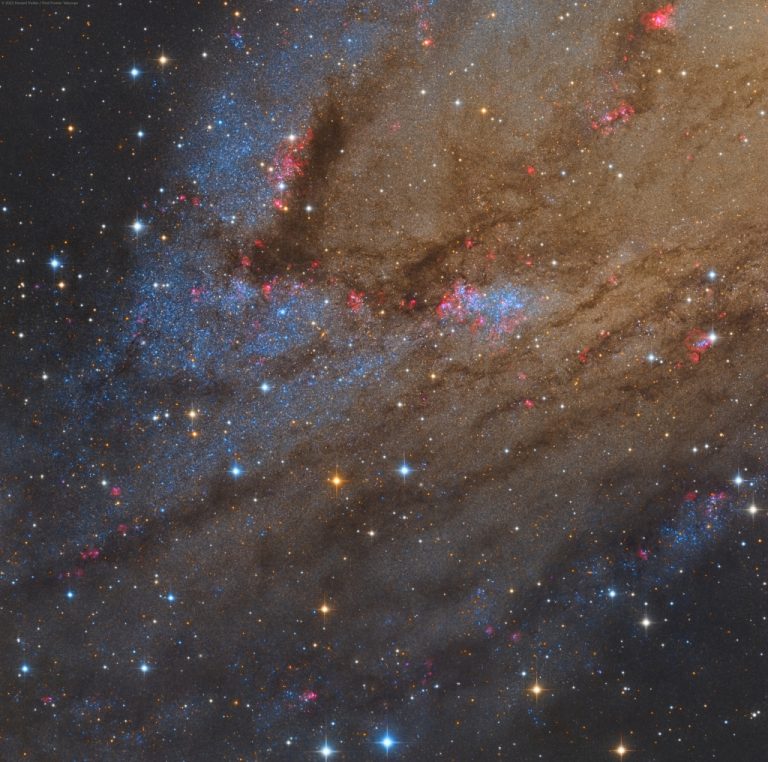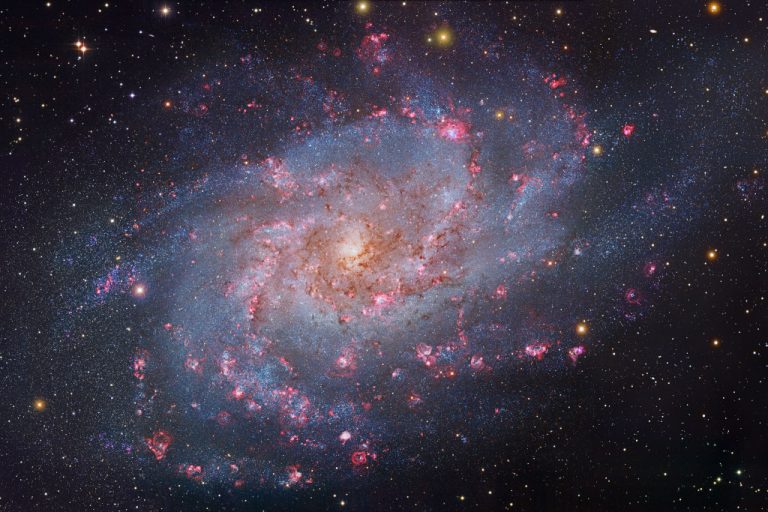哈勃影像: 仙女座星系的拼接图
See Explanation. Clicking on the picture will download the highest resolution version available.
请参阅说明。单击图片将下载可用的最高分辨率版本。

See Explanation. Clicking on the picture will download the highest resolution version available.
请参阅说明。单击图片将下载可用的最高分辨率版本。

See Explanation. Clicking on the picture will download the highest resolution version available.
请参阅说明。单击图片将下载可用的最高分辨率版本。

The featured image shows a spiral galaxy and a smaller oval galaxy in a dark starfield. Please see the explanation for more detailed information.
特色图片展示了黑暗星场中的一个螺旋星系和一个较小的椭圆星系。有关更多详细信息,请参阅说明。

2023年11月13日 Andromeda over the Alps Image Credit & Copyright: Dzmitry Kananovich Explanation: Have you ever seen the Andromeda galaxy? Although M31 appears as a faint and fuzzy blob to the unaided eye, the light you see will be over two million years old, making it likely the oldest light you ever will see directly. The featured image captured Andromeda just before it set behind the Swiss Alps early last year. As cool as it may be to see this neighboring galaxy to our Milky Way with your own eyes, long duration camera exposures can pick up many faint and breathtaking details. The image is composite of foreground and background images taken consecutively with the same camera and from the same location. Recent data indicate that…

2023年10月6日 The Once and Future Stars of Andromeda Image Credit: NASA, NSF, NOAJ, Hubble, Subaru, Mayall, DSS, Spitzer; Processing & Copyright: Robert Gendler & Russell Croman Explanation: This picture of Andromeda shows not only where stars are now, but where stars will be. The big, beautiful Andromeda Galaxy, M31, is a spiral galaxy a mere 2.5 million light-years away. Image data from space-based and ground-based observatories have been combined here to produce this intriguing composite view of Andromeda at wavelengths both inside and outside normally visible light. The visible light shows where M31’s stars are now, highlighted in white and blue hues and imaged by the Hubble, Subaru, and Mayall telescopes. The infrared light shows where M31’s future stars will soon form, highlighted in orange…

2023年8月23日 The Meteor and the Galaxy Credit & Copyright: Jose Pedrero Explanation: It came from outer space. It — in this case a sand-sized bit of a comet nucleus — was likely ejected many years ago from Sun-orbiting Comet Swift-Tuttle, but then continued to orbit the Sun alone. When the Earth crossed through this orbit, the piece of comet debris impacted the atmosphere of our fair planet and was seen as a meteor. This meteor deteriorated, causing gases to be emitted that glowed in colors emitted by its component elements. The featured image was taken last week from Castilla La Mancha, Spain, during the peak night of the Perseids meteor shower. The picturesque meteor streak happened to appear in the only one of 50 frames…

2023年4月12日 NGC 206 and the Star Clouds of Andromeda Image Credit & Copyright: Howard Trottier Explanation: The large stellar association cataloged as NGC 206 is nestled within the dusty arms of the neighboring Andromeda galaxy along with the galaxy’s pinkish star-forming regions. Also known as M31, the spiral galaxy is a mere 2.5 million light-years away. NGC 206 is found right of center in this sharp and detailed close-up of the southwestern extent of Andromeda’s disk. The bright, blue stars of NGC 206 indicate its youth. In fact, its youngest massive stars are less than 10 million years old. Much larger than the open or galactic clusters of young stars in the disk of our Milky Way galaxy, NGC 206 spans about 4,000 light-years. That’s…

2023年3月22日 M31: The Andromeda Galaxy Image Credit & Copyright: Abdullah Al-Harbi Explanation: How far can you see? The most distant object easily visible to the unaided eye is M31, the great Andromeda Galaxy, over two million light-years away. Without a telescope, even this immense spiral galaxy appears as an unremarkable, faint, nebulous cloud in the constellation Andromeda. But a bright white nucleus, dark winding dust lanes, luminous blue spiral arms, and bright red emission nebulas are recorded in this stunning fifteen-hour telescopic digital mosaic of our closest major galactic neighbor. But how do we know this spiral nebula is really so far away? This question was central to the famous Shapley-Curtis debate of 1920. M31’s great distance was determined in the 1920s by observations that…

2023年1月17日 Unexpected Clouds Toward the Andromeda Galaxy Image Credit & Copyright: Yann Sainty & Marcel Drechsler Explanation: Why are there oxygen-emitting arcs near the direction of the Andromeda galaxy? No one is sure. The gas arcs, shown in blue, were discovered and first confirmed by amateur astronomers just last year. The two main origin hypotheses for the arcs are that they really are close to Andromeda (M31), or that they are just coincidentally placed gas filaments in our Milky Way galaxy. Adding to the mystery is that arcs were not seen in previous deep images of M31 taken primarily in light emitted by hydrogen, and that other, more distant galaxies have not been generally noted as showing similar oxygen-emitting structures. Dedicated amateurs using commercial telescopes…

2022年11月3日 M33: The Triangulum Galaxy Image Credit & Copyright: Processing – Robert Gendler Data – Hubble Legacy Archive, KPNO, NOIRLab, NSF, Aura, Amateur Sources Explanation: The small, northern constellation Triangulum harbors this magnificent face-on spiral galaxy, M33. Its popular names include the Pinwheel Galaxy or just the Triangulum Galaxy. M33 is over 50,000 light-years in diameter, third largest in the Local Group of galaxies after the Andromeda Galaxy (M31), and our own Milky Way. About 3 million light-years from the Milky Way, M33 is itself thought to be a satellite of the Andromeda Galaxy and astronomers in these two galaxies would likely have spectacular views of each other’s grand spiral star systems. As for the view from the Milky Way, this sharp image combines data…